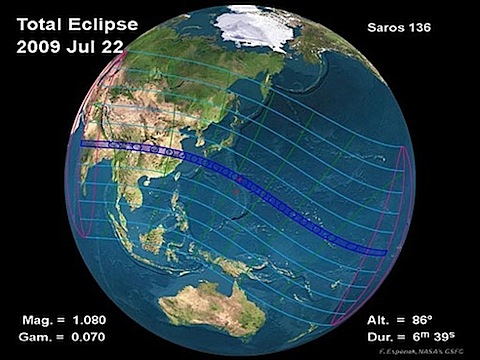Joshua Foer is a guest blogger on Boing Boing. Joshua is a freelance science journalist and the co-founder of the Atlas Obscura: A Compendium of the World's Wonders, Curiosities, and Esoterica, with Dylan Thuras.

Last summer, I read Roberto Casati's wonderful, lyrical book Shadows: Unlocking their Secrets, from Plato to Our Time, and was struck by a passage in which Casati describes how his addiction to total solar eclipses (TSEs) has carried him to the middle of the Black Sea and to Zambia:
A total eclipse is by far the most impressive natural phenomenon that we terrestrials can witness. The staging doesn't lessen its brutal effects. The temperature drops. A mysterious cold wind starts blowing. The shadow comes running up like a hurricane on the sea. The light collapses, and in just a few seconds, a metallic night falls–it comes on so fast the mind is not ready for it. On the horizon, unreachably far away, are the vestiges of daytime: an orangy twilight all around, as if a set designer made a mistake in projecting a sunset. In the midst of all this is a sun that's no longer a furnace but just an unlucky rock: its shining fringe is like the silver mane of hair of some aged celestial divinity; and stars glitter again, caught out of place in this out-of-joint nighttime.
Sounds like an almost religious experience, doesn't it?
TSEs happen about once every other year, and are only visible in a narrow band of the earth's surface. When I first read Casati's book, I vowed that I would try to see one as soon as possible.
I had high hopes of being in the Siberian town of Nadym for the last TSE, on August 1, 2008, but another commitment kept me in another hemisphere. Alas, I'm also going to be glued to my desk for the next TSE, which is exactly a month away, on July 22. Since it's going to pass over major populated areas in India and China, it may end up being witnessed by more human beings than any other TSE in history. It's also going to be the longest of the 21st century, lasting 6 minutes and 39 seconds at its point of maximum eclipse.
The next four TSEs–in 2010, 2012, 2015, and 2016–will barely cross dry land. So unless you want to join a cruise expedition or do some airborne eclipse chasing, you'll have to wait for the 2017 eclipse, which is going to carve a big fat path across the American heartland. For more info, check out Totality: The Digital Magazine for Eclipse Chasers.






